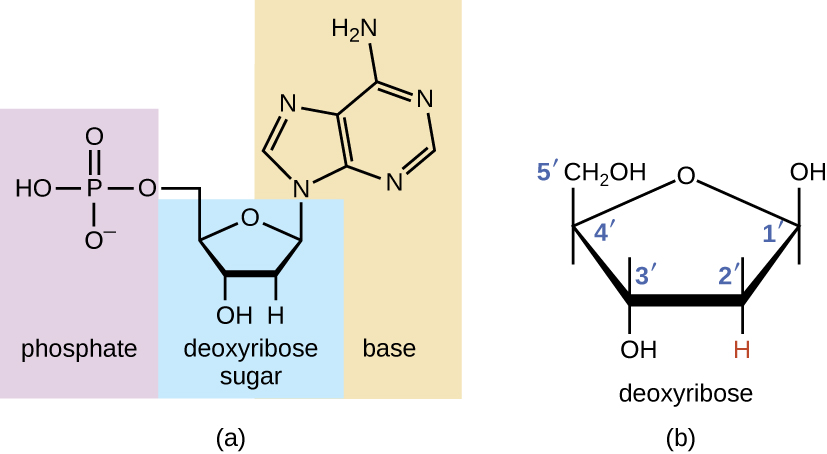| << Chapter < Page | Chapter >> Page > |
In Microbial Metabolism , we discussed three classes of macromolecules: proteins, lipids, and carbohydrates. In this chapter, we will discuss a fourth class of macromolecules: nucleic acids. Like other macromolecules, nucleic acid s are composed of monomers, called nucleotide s, which are polymerized to form large strands. Each nucleic acid strand contains certain nucleotides that appear in a certain order within the strand, called its base sequence . The base sequence of deoxyribonucleic acid (DNA) is responsible for carrying and retaining the hereditary information in a cell. In Mechanisms of Microbial Genetics , we will discuss in detail the ways in which DNA uses its own base sequence to direct its own synthesis, as well as the synthesis of RNA and proteins, which, in turn, gives rise to products with diverse structure and function. In this section, we will discuss the basic structure and function of DNA.
The building blocks of nucleic acids are nucleotides. Nucleotides that compose DNA are called deoxyribonucleotides . The three components of a deoxyribonucleotide are a five-carbon sugar called deoxyribose , a phosphate group, and a nitrogenous base , a nitrogen-containing ring structure that is responsible for complementary base pairing between nucleic acid strands ( [link] ). The carbon atoms of the five-carbon deoxyribose are numbered 1ʹ, 2ʹ, 3ʹ, 4ʹ, and 5ʹ (1ʹ is read as “one prime”). A nucleoside comprises the five-carbon sugar and nitrogenous base.

The deoxyribonucleotide is named according to the nitrogenous bases ( [link] ). The nitrogenous bases adenine (A) and guanine (G) are the purines ; they have a double-ring structure with a six-carbon ring fused to a five-carbon ring. The pyrimidines , cytosine (C) and thymine (T), are smaller nitrogenous bases that have only a six-carbon ring structure.

Individual nucleoside triphosphates combine with each other by covalent bonds known as 5ʹ-3ʹ phosphodiester bonds , or linkages whereby the phosphate group attached to the 5ʹ carbon of the sugar of one nucleotide bonds to the hydroxyl group of the 3ʹ carbon of the sugar of the next nucleotide. Phosphodiester bonding between nucleotides forms the sugar-phosphate backbone , the alternating sugar-phosphate structure composing the framework of a nucleic acid strand ( [link] ). During the polymerization process, deoxynucleotide triphosphates (dNTP) are used. To construct the sugar-phosphate backbone, the two terminal phosphates are released from the dNTP as a pyrophosphate. The resulting strand of nucleic acid has a free phosphate group at the 5ʹ carbon end and a free hydroxyl group at the 3ʹ carbon end. The two unused phosphate groups from the nucleotide triphosphate are released as pyrophosphate during phosphodiester bond formation. Pyrophosphate is subsequently hydrolyzed, releasing the energy used to drive nucleotide polymerization.

Notification Switch
Would you like to follow the 'Microbiology' conversation and receive update notifications?